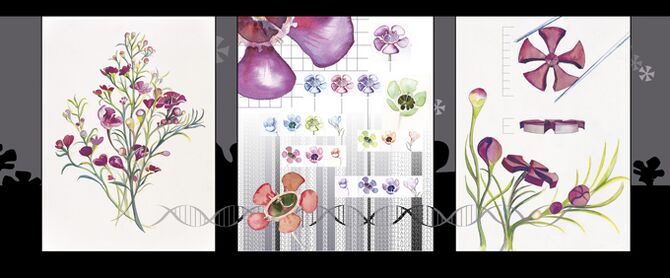20.109(F11): Mod 3 Day 1 Growth of phage materials
Growth of phage materials
Introduction
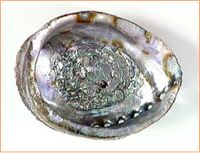
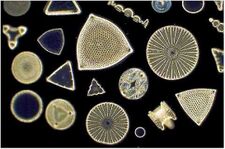
The accomplishments of the natural world can inspire us to great engineering feats. Biomineralization is one particularly impressive trick nature pulls off. Vertebrates, invertebrates and plants all have ways to precisely position inorganic substrates into crystalline order. For example, calcium carbonate will form unstructured dust in the absence of genetically-programmed organizers, but the same material can be made into the hard and luminous shells of sea creatures. Similarly, diatoms organize silicon dioxide into intricate patterns that manufacturers of electronic components can’t begin to approach. In one more instance, bacteria align iron inside their cytoplasm to form magnetic rods on the submicron scale. These feats are accomplished without harsh chemicals, without extreme temperatures, and without noxious wastes that poison the nests of the organisms themselves. Humans have a lot to learn from nature’s successes. In the upcoming weeks we’ll use a virus that infects bacteria, namely the bacteriophage M13, and we'll rely on the self-assembling coat of this virus to template carbon nanotubes and TiO2. The interaction of these materials with a protein on the phage coat yields nanoscale-particles with useful energetic properties, as we’ll see.
About M13
The bacteriophage M13 is a member of the filamentous phage family. It has a long (~900 nm), narrow (~20 nm) protein coat that encases a small (~6.4 kb) single stranded DNA genome. The genome encodes 11 proteins, five of which are exposed on the phage’s protein coat and six of which are involved in phage maturation inside its E. coli host. The phage coat is primarily assembled from a 50 amino acid protein called pVIII (or p8), which is sensibly enough encoded by gene VIII (or g8) in the phage genome. For a wild type M13 particle, it takes about ~2700 copies of p8 to make the ~900 nm long coat. The coat's dimensions are flexible though and the number of p8 copies adjusts to accommodate the size of the single stranded genome it packages. For example, when the phage genome was mutated to reduce its number of DNA bases (from 6.4 kb to 221 bp) [2], then the p8 coat “shrink wraps" around the reduced genome, decreasing the number of p8 copies to less than 100. Electron micrographs of the resulting “microphage” and its wild type parent are shown below (image courtesy of Esther Bullitt, Boston University School of Medicine), where the black bar in each image is 50 nm long. And what about the upper limit to the length of the phage particle? Anecdotally, viable phage seems to top out at approximately twice the natural DNA content. However, deletion of a phage protein (p3) prevents full escape from the host E. coli, and phages that are 10-20X the normal length with several copies of the phage genome can be seen shedding from the E. coli host.

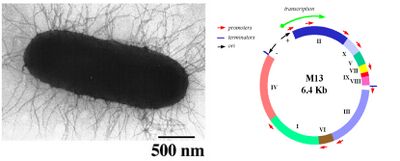
Phage life-cycle
The general stages to a viral life cycle are: infection, replication of the viral genome, assembly of new viral particles and then release of the progeny particles from the host. Filamentous phages use a protein at their tip, namely p3, to contact a bacterial structure known as the F pilus to infect E. coli. The phage genome is then transferred through the pilus to the cytoplasm of the bacterial cell where resident proteins convert the single stranded DNA genome to a double stranded replicative form (“RF”). This DNA then serves as a template for expression of the phage genes and produces new phage particles that shed off the surface of the infected cell. Other phage are known to lyse their host cells but in the case of M13 and E. coli, they co-exist in a balanced way, allowing the growth of both host and virus, though the infection does slow down the doubling time of the E. coli, causing "plaques" to form in a bacterial lawn.
Phage display
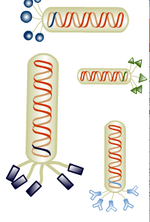
Nonetheless, peptides with remarkably diverse functions have been isolated with phage display. Once the fusion site is chosen, a library of sequences encoding random peptides can be synthesized and cloned. In this way a pool of phage, each with different fusions, can be made. Finally, the phage pool can be screened for interesting behaviors or properties. Peptide-fusion proteins to p8 or p3 that include stop codons or intolerable sequences are largely lost from the population after the first round of “panning.” Other phage that can bind to a substance of interest or show enzyme activity or glow green…, these remain and can be directly isolated from the pool or further enriched by a second, third, fourth round of panning. Ultimately anywhere from 10 to 1000 candidate sequences may remain from a starting pool of 1 billion [3].
Despite phage display techniques being available for more than a generation, this tool has been applied only recently to the search for novel materials. Largely it’s been Angela Belcher and her lab who highlighted and then demonstrated the usefulness of this search tool for finding peptides that interact with materials to meet human needs. That M13 could interact with inorganic materials could not have been predicted from the original genetic studies on the phage, but there was also no one who had tried it. Phage that can bind to cobalt oxide, gold, iridium and indium tin oxide are all in-hand thanks to their work (e.g see reference [4]). Today you will harvest a phage that can bind to single-walled carbon nanotubes (SWNTs) and TiO2 since these can be used to build nanocomposites that will be assembled into a photovoltaic device before this module is over.
Protocols
In advance of this lab, a bacterial host ( XL1-blue) was infected with the modified M13 phage called "DSPH." The p8 modification (=DSPHTELP) was isolated from a library of p8 mutants that enable the phage to bind SWNTs doi:10.1038/nnano.2011.50. Today you will harvest the phage from the supernatant of the infected bacterial culture and then measure its concentration using the spectrophotometer. Before you leave you will react the phage with SWNTs so they'll be ready for the titanium next time.
Part 1: Phage purification
- Divide the overnight culture (~50 ml volume) into 2 Oak Ridge Centrifuge tubes
- Label with your group color using tape (not the small circles; these can come off in the rotor)
- Spin 10, 000 rpm, 10 minutes using a fixed angle rotor (you will be shown where down the hall you can find a centrifuge to spin this volume).
- Transfer the supernatant to a 50 ml conical tube and then clean your two Oak Ridge tubes by adding some 10% bleach and some water to the pellets, allowing the solutions to sit in the sink for 5 minutes and then washing the tubes with copious amounts of distilled water from the tap.
- Once the Oak Ridge tubes are clean, split the supernatant that is in the conical tube between the two Oak Ridge tubes. The transfer should be done with a plastic pipet and a bulb so you can measure the volume of supernatant.
- Add a 1/4th that volume of 20% PEG-8000/2.5M NaCl solution.
- Invert to mix then incubate on ice 60 minutes.
- Spin at 14,500 rpm for 15 minutes. A white pellet may be visible...these are your precipitated phage. If you can't see a pellet keep going, but be aware of where the pellet you can't see is in the tube and don't scrape a tip against it or you will accidentally remove it.
- Remove the supernatant by pouring most down the sink and the rest with aspiration (carefully so as not to disturb the pellet).
- Resuspend the pellet in 3 ml sterile H2O. This is best done by adding 3 ml of H2O to one of the Oak Ridge tubes, washing the water up and down the side of the tube with the phage pellet, and then moving the 3 ml of phage solution to the second tube and dissolving that pellet as well by washing the water up and down the side of the tube.
- Split the phage solution between three eppendorf tubes. For this part of the protocol, you will be given special eppendorf tubes that can hold 2 ml.
- Add a 1/4th volume of 20% PEG-8000/2.5M NaCl solution.
- Invert to mix. Then incubate on ice for 15 minutes.
- Spin the tubes full speed in a microfuge for 10 minutes.
- Aspirate the supernatant and resuspend the pellets (if you can see them) in 0.2 ml TBS--using 0.2 ml to resuspend one pellet and moving that volume to resuspend the next pellet, and then moving that volume again to resuspend the third pellet. This is your phage stock (yay!).
- If the solution looks at all cloudy, spin in a room temperature microfuge for 1 minute more and move supernatant with the phage to a new tube.
- Pool your volume of phage with that of two other teams (ask the teaching faculty which "super-team" you're on) and then measure the concentration of that mix as described in Part 2.
Part 2: Measuring concentration of phage
where
- the molar extinction coefficient of the phage and the average size of a DNA base are used collected into the constant
- the absorbance at 269 nm reflects the protein and DNA content in the solution
- the absorbance at 320 nm corrects for the naturally high baseline value of the solution
- the number of DNA bases in M13 is ~6400.
This method for titering the phage stock is less informative than the traditional plaque method since materials other than phage might be contributing to the absorbance readings and the number of infectious particles isn't truly known. Since the latter attribute is not critical for the synthesis of SWNT-TiO2 nanowires, we can give this a go...
- Dilute the phage stock you have 1:10 by adding 70 ul of the phage to 630 ul of TBS, vortex to mix and then move this solution to a quartz (not plastic!) cuvette.
- A few things to be aware of when using quartz cuvettes:
- They are very expensive.
- The lab has very few.
- When you are done using your cuvette, you should carefully clean it by shaking out the contents into the sink and rinsing it once with 70% EtOH, then two times with water. Quartz cuvettes get most of their chips and cracks when someone is shaking out the contents since it is so easy for the cuvette to slip from wet fingers or be hit against the sink. Don’t let this happen to you.
- A few things to be aware of when using quartz cuvettes:
- Read the absorbances of your phage dilution at 269 and 320, using TBS in a second quartz cuvette to blank the spectrophotometer at each wavelength.
- Calculate the number of phage particles/ml using the formula shown above.
Part 3: Dialysis of phage with SWNTs
The class will be testing the solar cell's efficacy as a function of the ratio of phage to SWNTs in this next synthesis reaction. There will be one "super-team" (made up of two or three groups) that will test a 1:1 ratio of SWNTs:phage. Another super-team will test 2.5:1 and a third super-team will test 5:1. The table below indicated the appropriate mass and phage particles to use, assuming a phage concentration of about 4x10^13 phage/ml. If the phage stock you have isolated is lower or higher, you will have to adjust the mass of SWNTs accordingly.
| SWNTs (ug) | phage (# of particles)* | |
|---|---|---|
| 1:1 | 40 | 4x10^13 |
| 2.5:1 | 100 | 4x10^13 |
| 5:1 | 200 | 4x10^13 |
- Volume of phage should be between 0.5 and 5 ml to give this number of phage particles
- Prepare the tubing you'll need for dialysis. We will use dialysis tubing with a molecular weight cutoff of 12,000-14,000 against a pH'd solution of NaCl in order to change the electrostatic properties of the phage inside the bag. You should always wear gloves when handling the dialysis tubing.
- Cut a length of tubing that is 20 cm long for the narrow tubing, or 7 cm for the wide tubing.
- Soak the tubing in 50 ml dH2O in a falcon tube. It is recommended that the tubing soaks for 20 minutes, but a shorter time is fine too.
- Clips for the tubing are numbered in pairs and you should note which pair you have. Next time, this number will be the only way to distinguish your sample from the others.
- Open both clips. Remove the tubing from the water with a gloved hand and close one end with a clip, leaving ~0.5 cm overhang.
- Use a P1000 to transfer the phage solution to the tubing, being careful not to drop the tubing (it's slippery!) or let the liquid squirt out (so fill the tubing slowly with the tip low in the tubing).
- Use a P1000 to transfer the appropriate volume of SWNTs to the bag.
- Clamp the other end and dialyze the bag in 1 liter of 10mM NaCl, pH 5.3, with the other samples from the class. You may need to tie some teflon tape around the end of one of your clips and secure the other end of the teflon tape out of the liquid in order to keep your tubing from getting bashed around by the magnetic stir bar. After 2 hours, the NaCl will be replaced with fresh 10mM NaCl, pH 5.3. Tomorrow, one of the teaching faculty will refresh the beaker with clean 10 mM NaCl, pH 10 and the samples will remain in the beaker at room temperature until you return to lab.
Clean up
- The tubes that held the phage and bacterial culture can be rinsed with a squirt 10% bleach and then rinsed out well with water (three times is perfect). Place in the bin next to the sink (it will be washed in the dishwasher).
- Oak Ridge Centrifuge tubes: please rinse with a squirt of 10% bleach and then rinse out well with water (three times is perfect). Place in the bin next to the sink (it will be washed in the dishwasher).
- The quartz cuvettes can be returned, clean, to the instructors bench at the front of the room.
DONE!
For next time
The primary assignment for this experimental module will be for you and your partner to develop a scientific research proposal. For next time, please describe five recent findings that might define an interesting research question. You should hand in a 3-5 sentence description of each topic and list the reference that led you to each item. The topics you pick can be related to any aspect of the class, i.e. DNA, system engineering, or bio-material engineering. During lab next time, you and your partner will review the topics and narrow your choices, identifying one or perhaps two topics for further research.
Reagents list
20% PEG 8000, 2.5 M NaCl
TBS
- 50 mM Tris
- 150 mM NaCl
- pH 7.6
SWNTs
- Stock prepared by Belcher lab (thank you!!) = 20 ug/ml
10mM NaCl
- 0.5844 g/liter, pH to 5.3 or 10
